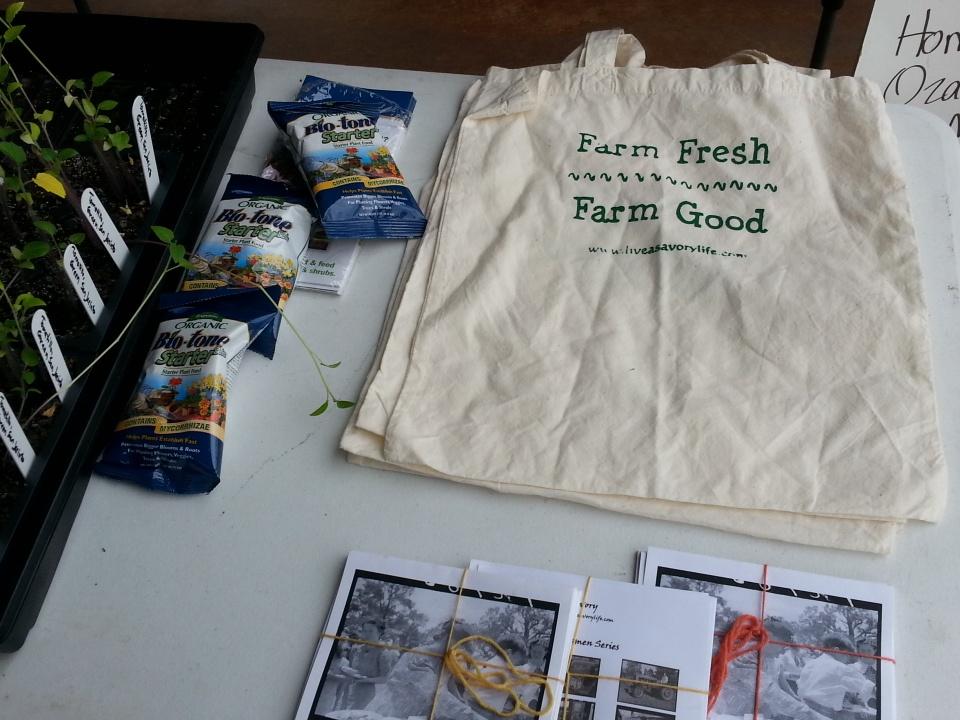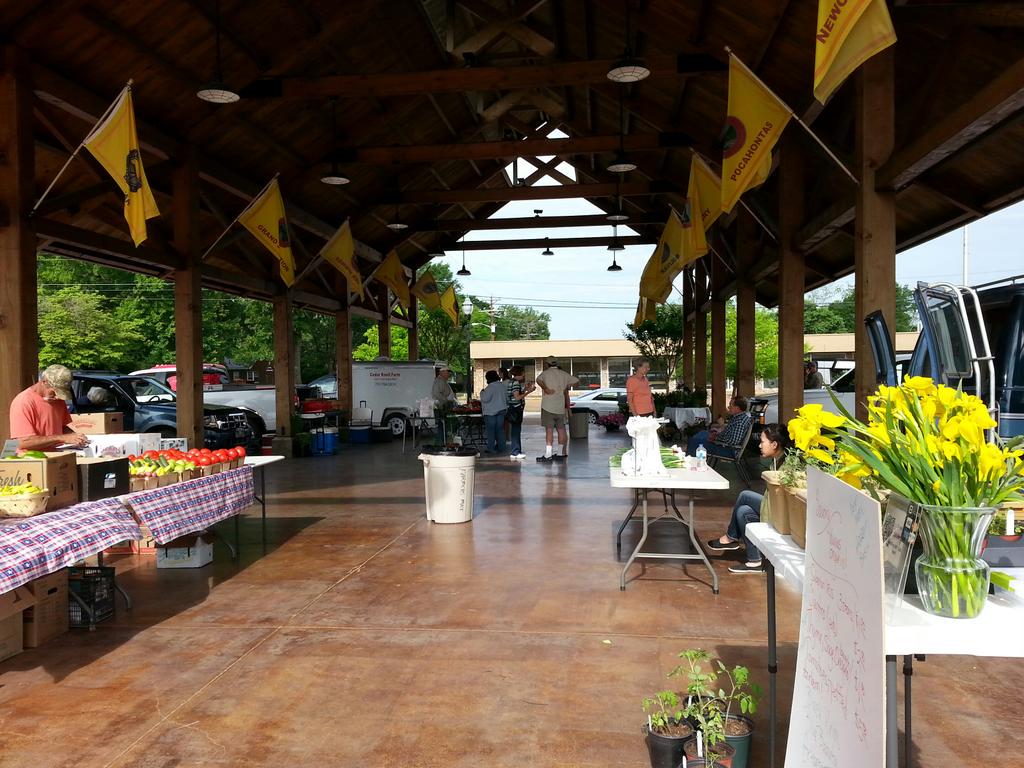Spent the day in the garden and this visitor fluttered by!
Friday, September 25, 2015
Saturday, June 27, 2015
"Tine" to Cut Costs!
When you're a micropreneur, you're always on the lookout for ways to cut costs. Here's one way I've made thrifty plant tags using index cards and plastic forks instead of those expensive plastic tridents.
Thursday, June 25, 2015
Knowing the Value of Your Suds
 |
| Recycle a used foaming soap dispenser |
 |
| Enjoy your foam! |
- Save used foaming soap dispenser.
- Fill 1/4 full with regular liquid hand soap (or castile soap and essential oil).
- Fill the remainder of the bottle (3/4) with warm water.
- Replace cap and shake to mix.
- Voila!
What about you? How are you frugally enjoying your Savory life?
Nancy
Monday, June 1, 2015
Ongoing Lessons in Entrepreneurship
 |
| Test-market before committing full resources to a new product line. |
Or, what I wish I had known from the start.
- Write your business plan, apply the rule of threes, then add a little more.
There are many, but my rule of threes states that your plan will take 3 times as long, cost 3 times as much, and revenues will be 1/3 of projections. This is especially true if you are trying to start a business while employed full-time elsewhere. You must sleep, after all, and there is a limit to the energy you can expend and maintain your money-making job.
- Small risk means small gain.
There's an old joke about the difference between an artist and a serious artist: a mortgage. It's true. Nothing lights a fire under you like "betting the farm," but, in the current financial climate, that seems too dangerous for someone as risk-averse as I am. So, I'm starting small and growing slowly. I'm still working my "day job" for the "steady" income.
- My customers are my "bosses."
One of the advertised benefits of entrepreneurship is that you can "be your own boss." This is, in a large sense, utter hogwash. If you're selling something--goods or services--your customers are your bosses and control you with their buying behaviors. Learn all you can about the identity and habits of your customer base and you'll make far fewer missteps.
- If you can afford the note, you can afford to save up for it.
I have a real problem with this. I am, admittedly, debt-averse--a stance developed through some hard lessons. Unless it is essential, avoid paying interest to anybody. Interest is money you pay to someone else because you were not disciplined enough to save in advance.
- Develop your marketing channels before you fully commit to production.
I know, I know: you can't sell something you haven't made. Actually, you can; swindlers do it all the time. The problem is: how can you ethically sell something you haven't made? Okay, make a few and see how they go over. See if there is any demand for your product. If there isn't, can you create a perceived need or value? If you're making something nobody is buying, you do not have a business: you have a hobby. |
| Remember that you're selling to people! |
- "I'm going to sell it on the Internet" is not a marketing plan.
Perhaps it's just what I sell, or that I'm totally inept at Etsy/whatever, but Internet marketing just doesn't work for me (and I have a college degree in Geek). My husband is a jewelry artist and has sold, maybe, 5 pieces on our Etsy store (yes, our pictures are awful). That conversion rate is infinitesimal. He also sells at art fairs and crafts fairs where our conversion rate is about 25%. If you walk into our booth, there's a 1-in-4 chance you'll buy something. Part of that gorgeous booth design, but a big part is experienced inside-sales staff who know the questions to ask to make recommendations for the customer. My point is, Internet sales are all the rage, but our bread-and-butter is grassroots face-to-face retail.
- Control costs.
Cost control is the difference between success and failure. In your personal life, each dollar you spend costs you at least $1.25 to make. If you follow that trend in your business, you'll soon be out of business. Margin is the difference between what it costs to make your product and what your customers pay for your product. The bigger the margin, the more you can pocket or reinvest in your business. While you're minimizing costs, always be on the lookout for value. Make sure that you're not degrading your product quality in the name of cost control.
- Know when to say when.
If you're not making money, and you've given your business adequate time to develop, and you're not having fun, and you can quit without losing the farm, stop. Do something else. Do nothing else. Take a break before your next big idea. Give it your all, but, when your all isn't enough, stop.
- So, you're going to see me on next month's cover of Entrepreneur magazine, right?
Um, no. I'm not trying to sell you a subscription or some high-priced webinar. I'm not scamming investors; I'm not taking out big loans; I'm not courting venture capitalists. I'm a small-potatoes micropreneur sharing the lessons she's still learning on her way to building a successful retirement business. I hope you can learn from my mistakes, and build your own successful business!
What lessons have you learned? Share them in the comments below!
Nancy
Sunday, April 19, 2015
2015 Plants for Sale
Our mobile visitors cannot see the product list, so, here 'tis!
Broccoli: Waltham 29: Tolerates cold well, but may “button” at colder temperatures.
Broccoli: Early Purple Sprouting: Tolerates cold well, may “button” at colder temperatures.
Broccoli: Calabrese Sprouting: new variety; Likes somewhat warmer temperatures.
Broccoli: Umpquah: Likes somewhat warmer temperatures.
Cabbage: Early Flat Dutch: new variety; reported to be good for kraut!
Note: All standard tomato varieties are indeterminate and should be staked or trellised.
Ozark Pink: survived a tomato hornworm invasion, produced throughout the season; good flavor.
Arkansas Traveler: survived hornworm onslaught, produced late into the season, good flavor; Arkansas name connection.
Cherokee Purple: survived hornworm invasion, good producer, excellent flavor.
Black Trifele: survived hornworm onslaught; flavor-wise, probably my favorite because of its mild and smoky flavor; much smaller than a pear for me, with a few cracks. Not a prolific producer, but worth the trouble.
Black Krim: survived hornworm onslaught; name recognition; good flavor.
Arkansas Marvel: new variety: catalog description: "4-inch, 1 lb., meaty, yellow-orange beefsteak tomatoes with red marbling with a gush of wonderful sweet, well-balanced tomato flavors”
Homestead 24: new variety: catalog description: "smooth, red, round 8 oz. fruits with exceptionally good taste"
Early Annie: short plant with few seeds, good flavor, actually produced all season for me.
San Marzano Gigante: the legendary flavor and twice the size!; good flavor, and excellent producer; prolific nearly until
frost; recognizable name; I'm actually planting San Marzano Redorta this year, but looking forward to a good harvest
Hawaiian Currant: Bracts of red, tiny, sweet, tasty tomatoes
Gold Rush Currant: Heavy producer of bracts of tiny orange tomatoes, great flavor
Chinese Five-Color: hot; new variety; beautiful edible ornamental whose fruit ranges through green, white, orange, and red; reported Scoville 50,000
Tam Jalapeno: hot; good producer, nice-sized fruit; reported Scoville 4,500
Jupiter: sweet; new variety; thick-walled, disease-resistant bell
Ozark Giant: sweet; good producer, medium size bells, produced until frost last year
Email: savory@liveasavorylife.com
www.liveasavorylife.com
2015 Organic, non-GMO Transplants
Find us at the Fayette County Farmer's Market beginning March 28
Early Vegetables: Transplants expected to be ready March 28
Broccoli: Waltham 29: Tolerates cold well, but may “button” at colder temperatures.
Broccoli: Early Purple Sprouting: Tolerates cold well, may “button” at colder temperatures.
Broccoli: Calabrese Sprouting: new variety; Likes somewhat warmer temperatures.
Broccoli: Umpquah: Likes somewhat warmer temperatures.
Cabbage: Early Flat Dutch: new variety; reported to be good for kraut!
Tomatoes: Transplants expected to be ready after April 22
Note: All standard tomato varieties are indeterminate and should be staked or trellised.
Table
Ozark Pink: survived a tomato hornworm invasion, produced throughout the season; good flavor.
Arkansas Traveler: survived hornworm onslaught, produced late into the season, good flavor; Arkansas name connection.
Cherokee Purple: survived hornworm invasion, good producer, excellent flavor.
Black Trifele: survived hornworm onslaught; flavor-wise, probably my favorite because of its mild and smoky flavor; much smaller than a pear for me, with a few cracks. Not a prolific producer, but worth the trouble.
Black Krim: survived hornworm onslaught; name recognition; good flavor.
Arkansas Marvel: new variety: catalog description: "4-inch, 1 lb., meaty, yellow-orange beefsteak tomatoes with red marbling with a gush of wonderful sweet, well-balanced tomato flavors”
Homestead 24: new variety: catalog description: "smooth, red, round 8 oz. fruits with exceptionally good taste"
Canning/Paste
Early Annie: short plant with few seeds, good flavor, actually produced all season for me.
San Marzano Gigante: the legendary flavor and twice the size!; good flavor, and excellent producer; prolific nearly until
frost; recognizable name; I'm actually planting San Marzano Redorta this year, but looking forward to a good harvest
Currant
Hawaiian Currant: Bracts of red, tiny, sweet, tasty tomatoes
Gold Rush Currant: Heavy producer of bracts of tiny orange tomatoes, great flavor
Peppers: Transplants expected to be ready after May 15
Chinese Five-Color: hot; new variety; beautiful edible ornamental whose fruit ranges through green, white, orange, and red; reported Scoville 50,000
Tam Jalapeno: hot; good producer, nice-sized fruit; reported Scoville 4,500
Jupiter: sweet; new variety; thick-walled, disease-resistant bell
Ozark Giant: sweet; good producer, medium size bells, produced until frost last year
Email: savory@liveasavorylife.com
www.liveasavorylife.com
Subscribe to:
Posts (Atom)



